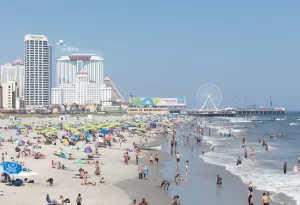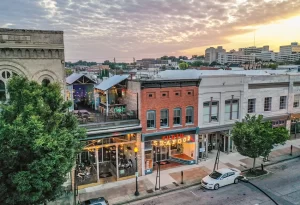With the fabled highway’s centennial coming up in 2026, now is the time to plan a road trip into yesteryear. Oklahoma communities have the welcome mat out.
Though it was replaced by five interstate highways decades ago, Route 66 will forever be remembered as the quintessential American road. The 2,448-mile asphalt artery linking the heartland to the West Coast has come to symbolize wanderlust and the heyday of automobile travel.
Happily for nostalgia fans like me, the Mother Road lives on, thanks in large part to communities that have helped preserve its past. Vast stretches of the old two-lane ribbon of pavement are still open to traffic, allowing travelers to cruise down memory lane as they stop at quirky roadside attractions, diners and drive-ins, souvenir shops and cozy, mom-and-pop motels that hark back to simpler times.
Oklahoma has 432 drivable miles of Route 66, more than any other state. I started my recent week-long trip in the northeastern region, spending two days checking out the must-see sights between Commerce and Tulsa.
Start Your Journey in Commerce and Miami
Commerce, a Route 66 town not far from the Kansas and Missouri borders, keeps alive the memory of its favorite son, New York Yankees baseball great Mickey Mantle. The main drag is Mickey Mantle Boulevard, Mantle’s modest boyhood home (not open to the public) has been restored to its 1938 appearance, and the water tower is painted in blue pinstripes with his uniform’s No. 7. A statue of the “Commerce Comet” stands at the high school’s Mickey Mantle Field.
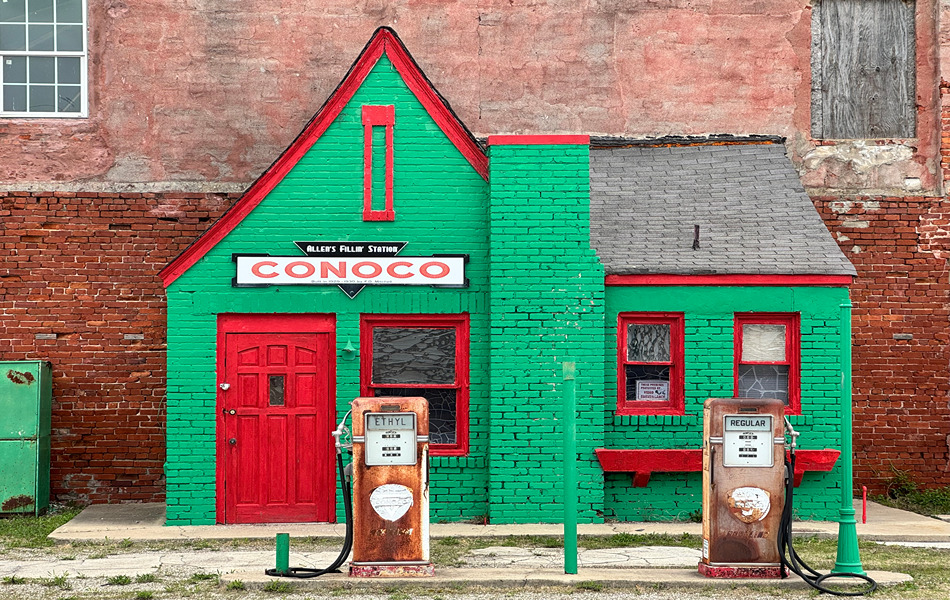
Allen’s Conoco Fillin’ Station, a popular Route 66 stop in Commerce, Oklahoma. (Randy Mink Photo)
Mother Road fans in Commerce also will want to stop at the 1929 Allen’s Conoco Fillin’ Station, which owns the undisputed title of being the smallest old-time gas station on Route 66. Built into the side of a large brick building, the quaint, hole-in-the-wall cottage, painted a festive green and red and sporting rusted gas pumps, provides an inviting photo op.
In a converted 1927 Marathon service station across the street, Dairy King drive-through serves up burgers, coneys, shakes, malts, soft-serve ice cream and Route 66 shield-shape cookies.
I love old theaters that have been restored to their vaudeville and movie-palace glory days, so a tour of the 1929 Coleman Theatre provided a fine introduction to the town of Miami (pronounced “My-am-uh”). My first impression: what a grand theater for such a small town (pop. 13,500).
A Spanish Colonial Mission-style building with an opulent Louis XV interior, the palatial Route 66 venue boasts rich mahogany woodwork, a magnificent chandelier and lots of gold leaf trim. Enhancing the exterior are a stucco facade, arched windows, red-tile roof, terra-cotta detailing and bell towers. Financed by a local mining magnate and later saved from the wrecking ball by preservation-minded citizens, the Coleman, now city-owned, was considered the most elaborate entertainment venue between Dallas and Kansas City.
The Coleman’s “Mighty Wurlitzer” pipe organ, which provided music and sound effects for silent movies, is the only Wurlitzer still in its original location. Groups of 25 or more can hear recorded organ music or even hire an organist to play as they dine on stage while taking in the architectural splendor. Guided tours are available, and groups can arrange to see a classic movie. A meal also can be served in the Coleman’s ballroom.
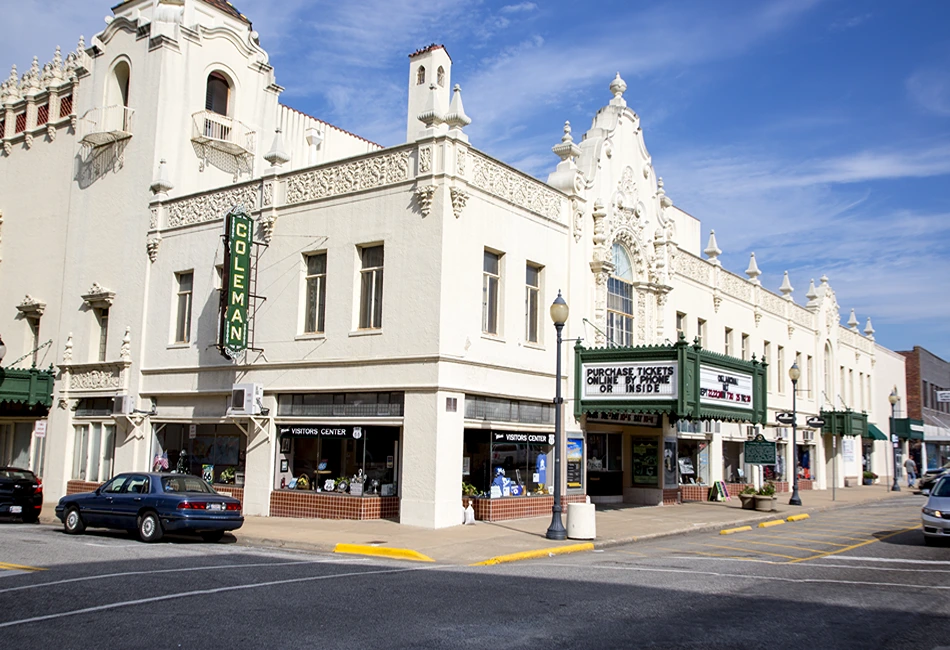
Coleman Theatre, a great group destination in Miami, Oklahoma. (Photo credit: Oklahoma Tourism & Recreation)
The theater’s playbill typically features concerts, musicals, comedians and other live performances. Silent movies are shown on occasion.
An on-stage meal option for groups is fast-food fare from Waylan’s Ku-Ku Burger, a Route 66 drive-in whose giant neon sign features a cuckoo clock and the namesake bird mascot. It’s the last remaining location of a popular 1960s chain. Famed for its cooked-to-order hamburgers, Waylan’s dishes up everything from corn dogs, chili dogs and pork tenderloin sandwiches to fried okra, fried pickle spears and frito pie. Treat yourself to a cone of Flavor Burst, a soft-serve ice cream striped with your choice of colorful syrup. The dining room is decorated with cuckoo clocks and Route 66 shield designs, while the parking lot has a few classic cars for show.
Miami boasts the longest stretch of Main Street on all of Route 66. More than 20 murals, some of them Route 66-themed, beautify downtown buildings. Also noteworthy: Miami is home to the headquarters of nine tribal nations.
Native American Heritage in Oklahoma
One of the state’s most prominent tribes showcases its heritage at the impressive Cherokee Nation Anna Mitchell Cultural and Welcome Center in Vinita, a pleasant Route 66 stop between Miami and Foyil. Travelers find arts and crafts exhibits, a gift shop and grab-and-go cafe. Outdoors, they like to pose with the sculpture A Bundle of Seven Arrows.
In Foyil, Ed Galloway’s Totem Pole Park, built by a retired veteran between 1937 and 1961, claims the World’s Largest Concrete Totem Pole. Brightly painted bas-relief designs depicting Native American culture decorate this premier example of folk art that soars 90 feet into the sky from a turtle-shape base and measures 18 feet in diameter. Oklahoma was called Indian Territory before earning statehood in 1907 and today is home to 39 tribes.
The nine-acre park, operated by the Rogers County Historical Society, includes 12 other sculptures that Galloway constructed. He also carved the wooden fiddles on display in the 11-sided Fiddle House gift shop, the workshop he built to resemble a Navajo hogan. The concrete tables and chairs painted in his trademark style make the park, four miles east of Route 66, an ideal stopping point for a picnic lunch.
Claremore’s Claims to Fame
The best-known Oklahoma Cherokee, humorist-philosopher-actor Will Rogers, is celebrated at the Will Rogers Memorial Museum in Claremore, a town of 21,000 situated in the heart of the Cherokee Nation. In fact, he was arguably the most famous person in the world in the 1920s and ’30s. At his peak Rogers was the highest paid male movie star and the most widely read syndicated newspaper columnist. Noted for his wit and wisdom, he also had the most popular Sunday evening radio show. Rogers’ homespun humor and timeless quotes (many of them jabs at politicians) still are relevant today.
Few museums this large honor a single individual other than a U.S. president; there is a lot to see and do, including watching movie clips and listening to radio broadcasts.
In an effort to interpret the Rogers’ legacy to the next generation and promote the concept of world citizenship, an expansion and redesign featuring AI and other high-tech enhancements will be unveiled in the next year or two. Upgrades will include a new event center, new landscaping, a dedicated entrance for tour groups, and welcome center with amenities for the bus driver and tour manager.
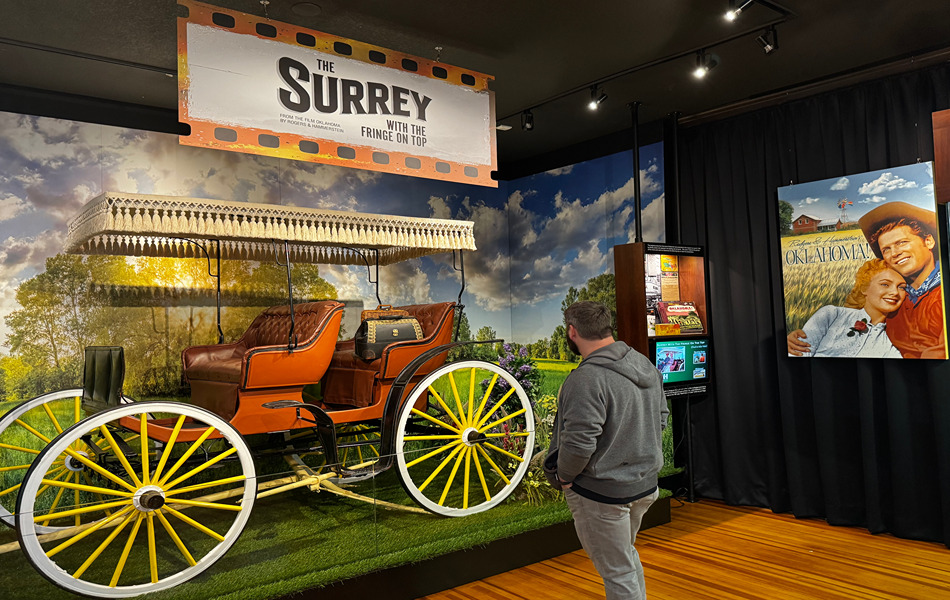
The Claremore Museum of History displays “The Surrey with the Fringe on Top” from the movie version of Rodgers & Hammerstein’s musical Oklahoma! (Randy Mink Photo)
Rogers, whose rise to fame started with a rope-trick act in vaudeville, was born during Indian Territory days on a nearby ranch. He lived in California most of his life but would visit Claremore and intended to retire on the hilltop where the museum and his burial site reside. The world mourned when Rogers, age 55, died in a plane accident in Alaska in 1935. On display are the battered typewriter, smashed eyeglasses and other items found at the crash site.
In a sunken garden on the museum grounds, Rogers’ tomb is inscribed with his most famous quote: “I never met a man I didn’t like.” A statue of the cowboy philosopher on horseback towers above the tomb and graves of family members.
Route 66 is known as the Will Rogers Highway, and his name pops up in place names throughout the state.
At the Claremore Museum of History, visitors can view a clip from the classic Rodgers & Hammerstein Broadway musical Oklahoma! and its most notable artifact, “The Surrey with the Fringe on Top,” a carriage featured in the 1955 movie version as Gordon MacRae serenaded Shirley Jones with the namesake song. The museum devotes one room to playwright Lynn Riggs, a Claremore native whose play Green Grow the Lilacs was adapted into the musical. It also spotlights Claremore’s Patti Page, “The Singin’ Rage,” one of the 1950s’ top recording artists.
Catoosa’s Oversized Oddity
Floating in his own pond next to a picnic area, the Blue Whale in Catoosa epitomizes the kitschy roadside curiosities that motorists encountered on Route 66. The smiling marine mammal, a cement behemoth measuring 80 feet long, is one of the most iconic landmarks along the legendary ribbon of pavement.

The Blue Whale of Catoosa, a must-see on Oklahoma Route 66. (Photo credit: Oklahoma Tourism & Recreation)
Thanks to the state’s grant program targeting Route 66’s 100th anniversary, travelers dropping by the Blue Whale soon will find a spiffy new visitor center, neon sign, picnic area and playground, along with a waterfall, pond-circling path and nature trails. Built by Hugh Davis for his wife in 1972, the site became a play area for their grandkids and then a swim park/fishing hole enjoyed by locals and Route 66 wayfarers.
The D. W. Correll Museum, also in Catoosa, has antique cars and a collection of rocks, fossils, minerals and arrowheads.
Tulsa Brims with Route 66 Lore
Mother Road enthusiasts find numerous treasures in Tulsa, especially along 11th Street with its neon Route 66 signs, colorful murals and old motor courts. Called the Capital of Route 66, the city has a 28-mile stretch of Route 66 to explore.
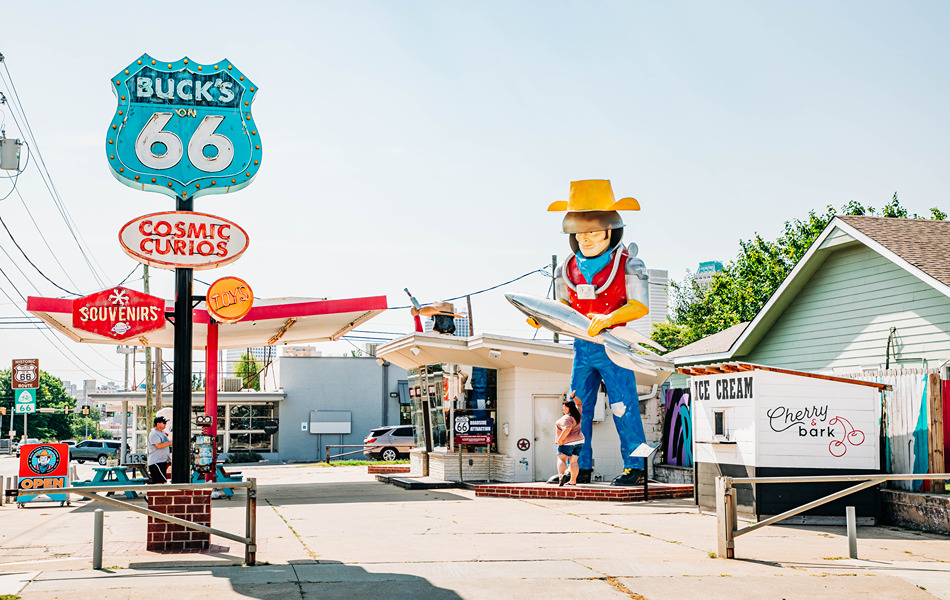
Giant statues at Buck Atom’s Cosmic Curios in Tulsa reflect the spirit of Route 66, known for its roadside attention-grabbers. (Photo credit: Oklahoma Tourism & Recreation)
Selfie spots in the Meadow Gold District, named for the huge neon dairy company sign at 11th and Quaker Avenue, include the newly installed space cowboy and cowgirl statues at Buck Atom’s Cosmic Curios souvenir store, one of several fun shops and galleries on 11th Street. Such 20-foot-tall fiberglass figures, referred to as “Muffler Men” by pop culture historians, were considered the height of outdoor advertising in the 1960s.
Ike’s Chili, Tulsa’s oldest restaurant, has graced the Meadow Gold District since 2014. Try its scrumptious chili in a coney, over spaghetti or in a bowl with macaroni and cheese. I had the latter and was tempted to order a second bowl. Some top their chili with cheese, onion or jalapeno.
Occupying a special place in the hearts of Tulsans, the chili parlor was started by Ike Johnson and his nephew in 1908, and its recipe has been passed down through four generations. One fan of Ike’s was Will Rogers, who called its chili “a bowl of blessedness.”
In the Tulsa Market District, Mother Road Market is a food hall housed in a former grocery distribution warehouse. I went Cajun and feasted on gumbo, fried catfish and peach cobbler from Leroux’s Kitchen. The hall’s covered outdoor patio has a Route 66-themed mini golf course.

Ike’s Chili, a Tulsa favorite. (Photo credit: Oklahoma Tourism & Recreation)
Tulsa makes a strong case as the true birthplace of Route 66. Tulsa businessman and state highway commissioner Cyrus Avery was responsible for plotting out the paved highway and assigned the road its 66 number designation. The memory of the “Father of Route 66” is enshrined in larger-than-life bronze sculptures at Cyrus Avery Centennial Plaza, a great photo stop at the Arkansas River, on the edge of downtown. The artwork depicts Avery getting out of his Model T to help a farmer in a horse-drawn carriage, capturing the collision of the past and the future along the Mother Road.
Another great photo op is the 76-foot-tall Golden Driller statue. The concrete-and-plaster oil worker represents the industry that fueled Tulsa’s growth in the early 20th century. Looming over the entrance of Expo Square, it is one of the country’s tallest freestanding statues.
In Southwest Tulsa, more photo-worthy subjects await at Route 66 Historical Village, an open-air museum with a collection of old train cars and a towering 154-foot oil derrick, the tallest in North America. Its visitor center replicates a 1920s Phillips 66 gas station.
Tulsa’s Music Attractions
In the Tulsa Arts District, fans of music history will revel in the Woody Guthrie Center and Bob Dylan Center, a pair of side-by-side attractions that honor iconic American singer-songwriters. Films, artifacts and interactive exhibits immerse visitors in their lives and legacies. Guthrie, who grew up in Oklahoma, is best known for “This Land is Your Land.” Dylan, the “Ramblin’ Man,” was a great admirer of Guthrie’s and decided to house his archives right down the street.
More music memorabilia surfaces at The Church Studio, a church that another legendary musician, Leon Russell, transformed into a recording studio in 1972. He helped develop the Tulsa Sound, a mixture of blues, rock, country and other styles. Dylan, Eric Clapton, Willie Nelson, George Harrison, Bob Marley and other stars recorded there. Located on Studio Row in the heart of the Pearl District, the former home of Russell’s Shelter Records was recently restored and opened in 2021 as a world-class recording studio. Co-owner Teresa Knox is involved in other businesses on Studio Row, which has a record shop, art galleries and eateries.
Tours of The Church Studio are available, and, depending on schedules, may include a peek at a recording session.
For information on other Route 66 destinations, subscribe to Leisure Group Travel for FREE.
By Randy Mink, Senior Editor
Lead Photo – Dairy King drive-in, a Route 66 standby in Commerce, Oklahoma. (Randy Mink Photo)




